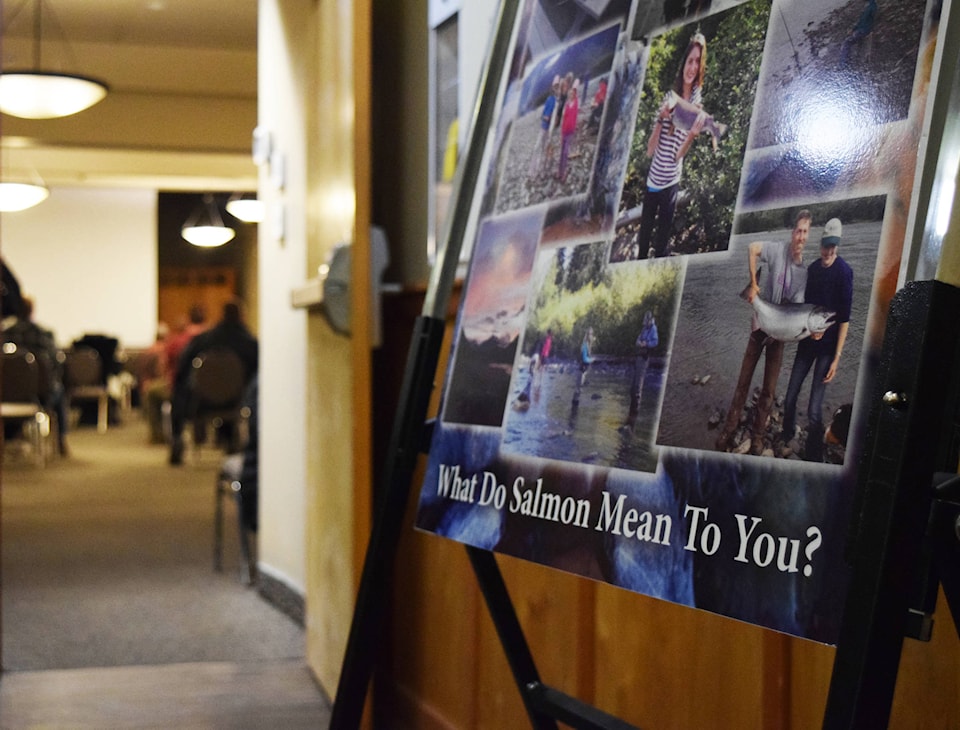Heated discussion with a dash of solutions was on the menu at an April 24 fish conservation talk in Smithers.
The night was hosted by the Bulkley Valley Rod and Gun Club and was billed as a chance for those concerned about declining salmon stocks in the Skeena watershed to cast their opinions on how to address the issue.
Mayor Taylor Bachrach, several town councillors and Skeena-Bulkley Valley MP Nathan Cullen were among some 150 who came out for the event.
But what was promoted as a discussion quickly devolved into debate, with the most common topic being Indigenous and non-Indigenous access to salmon.
While many spoke in support of Indigenous harvesting rights, a plurality of people at the event voiced concerns that a lack of consistent guidelines for reporting these catches makes it hard for the DFO to accurately gauge population levels.
After two people complained about the sale of fish off Highway 16 during a public question period, Wet’suwet’en elder Violet Gellenbeck responded to their comments.
“The fish that they sell is pink salmon. It’s not Chinook, it’s not sockeye and its not Coho, just for your information for those two men that spoke about my people selling fish.”
The conversation continued to devolve, with another speaker suggesting that Indigenous groups should be investing proceeds from their returns to Fisheries and Oceans Canada (DFO).
Similarily, speakers on the other side suggested current population decline is DFO’s fault and that they should have started restricting fishing many years earlier.
Gellenbeck echoed this view and said that Wet’suwet’en fisheries do communicate with the DFO.
“I belong to the Office of the Wet’suwet’en … every year in fishing season there is an agreement made with the Wet’suwet’en fisheries and the DFO,” she said.
Many also agreed with both perspectives and said that while Indigenous gathering rights are important, a consistent procedural framework among all Indigenous groups for reporting numbers of fish gathered to DFO is neccessary for population health of the species overall.
As the tension in the room began to increase, former president of the Bulkley Valley Rod and Gun Club Brian Atherton noted that the forum was for solutions, not blame, and the issue at hand is a problem that affects people without discrimination.
“We’re asking for solutions here,” he said, adding many of the issues discussed are moot if there are no salmon for anyone.
DFO’s North Coast director Colin Masson said ongoing conservation efforts in the Skeena watershed are a balancing act and the organization’s guidelines are an attempt to satisfy multiple groups with very different perspectives on the resource.
“There will be lots of people here that say, ‘well, maybe you’re being too precautionary’ and there will be other people in this very room who say, ‘it’s not precautionary enough’,” he said.
“It’s very difficult to get the right balance of … objectives like getting the fish to the spawning grounds, trying to meet the requirements for the indigenous fishery [and] trying to provide fish for recreational fishing in all areas,” he said, adding that the above issues don’t even take into account B.C.’s commercial fishing industry, which generated nearly $1.2 billion in sales for 2017.
DFO recently announced a number of restrictions on Chinook salmon populations in the Fraser river.
One of those restrictions is an overall reduction in the total annual limit of Chinook salmon someone can retain from 30 fish to 10.
The above restriction only applies to recreational anglers and does not affect Indigenous harversters.
Additional restrictions do, however, delay the start of Indigenous fisheries until July 15.
